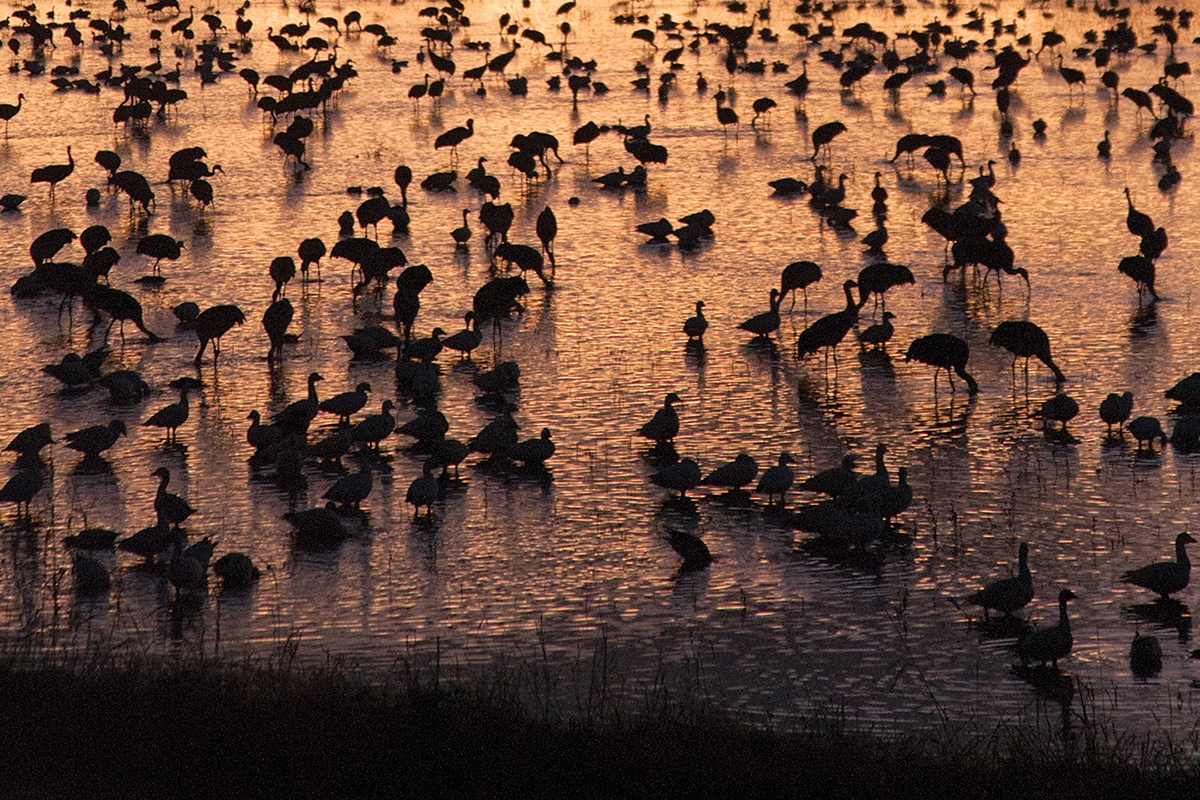Dawn arrives quietly at Muleshoe National Wildlife Refuge, a remote 6,440-acre parcel of the Panhandle’s short-grass prairie. A light breeze shakes the refuge’s blue grama, and gray clouds muffle the sound of the rustling grasses, smudging the sky as they cross the brightening horizon. A lone coyote pauses in a dry dirt track, listening for the titter of scaled quail. Mostly she’ll be met with silence.
The refuge approaches its stillest moment at daybreak, unless you arrive at the refuge between late October and early February. Then you’ll be treated to a rattling cacophony of morning performance so pervasive you’ll wonder if the sky is falling.
The refuge serves as wintering home to one of the largest populations of lesser sandhill cranes in North America, sizable birds whose numbers can reach 250,000 at the refuge during the January peak. Most mornings from late fall to early spring, thousands of cranes rise from the refuge’s three shallow, saline lakes, where they’ve spent the night. A great orchestration of crane song accompanies the birds as they take to the air, calling one another in high-pitched, staccato verse. The cranes fan out to the surrounding farmlands to feed on the milo, peanuts and corn abandoned in the dormant winter fields.
At dusk they return, cartwheeling out of the sky with loud cries, gliding down on massive wings until, flaps retracted, they stick a deft landing on thin legs. This gathering of sandhill cranes at dawn or dusk is one of the great wonders of the world, a sight to witness at least once in a lifetime.
Fortunately, the refuge makes sandhill crane watching easy by opening seven days a week, 24 hours a day with no admission fee. Muleshoe National Wildlife Refuge was established in 1935 (making it the oldest national wildlife refuge in the state) to preserve short-grass prairie, a rarity in the farmland-dominated Panhandle, and for its unusual habitat vital to a significant migratory bird population, including a catalog of ducks and the sandhill cranes.
But the refuge offers plenty of birding and wildlife watching year-round, even when the cranes are long gone. “The refuge provides the opportunity to see black-tailed prairie dogs, badgers, mule deer, foxes, bobcats and the occasional rattlesnake,” says Jude Smith, project leader for the Muleshoe, Grulle and Buffalo Lake national wildlife refuges. “Birding enthusiasts should watch the Muleshoe skies for golden eagles and Swainson’s hawks and look for burrowing owls around the prairie dog town,” Smith suggests. “Also, if you’re not familiar with saline lakes, then this is the place to see one for yourself.
We have three, and they always attract wildlife. Or tackle our hiking trails. We maintain two official trails—a short, quarter-mile nature trail and a mile-long stroll around one of the saline lakes. Or stick to our primitive road network and bring your mountain bike.”
The refuge is approximately 20 miles south of Muleshoe off State Highway 214 and another 2 miles along County Road 1248. Other than restrooms and its headquarters (open weekdays 8 a.m.–4 p.m.), the refuge offers no amenities. Bring comfortable walking shoes, binoculars, water and something to eat. If you wish to spend the night at the refuge, prepare for primitive tent camping. Campsites, also free, come with picnic tables, fire pits and restroom facilities but no potable water.
The ecology of Muleshoe National Wildlife Refuge represents its greatest allure for both naturalists and migrating sandhill cranes. But even if your enjoyment of the outdoors involves nothing more than backyard birding from your shaded patio, the refuge tenders an experience that you will not want to miss. After all, how could a quarter million birds be wrong?
———————————-
Photographer, author and artist E. Dan Klepper lives in Marathon.


